Are you interested in finding out whether Ancestry DNA can be used to find a biological father or mother? The answer is that yes, DNA testing is wonderful tool to help in the process.
In this post, I'll show you how I figured out the biological father of a close relative using a few clues and the Ancestry DNA test.
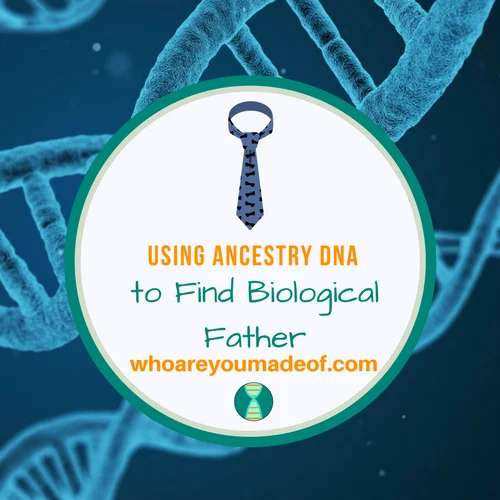
When I started out on my family tree research, I didn't get a whole lot of response from my family. Some people are more interested in learning about long-gone ancestors than others.
When they heard that I was going to do a DNA test, however, I got a few phone calls that started off something like this:
- "Well, you are probably going to find this out anyway, but..."
- "I don't know if you already know this, but..."
- "Just in case, you should probably know that..."
Secrets! It turns out, all families have them, and mine was no exception.
One "secret" that I learned about was that two close family members were "half" related to me (biologically speaking, of course... I still love them just as much as I did before I knew this information).
One of these family members knew who her biological father was, and had been in contact with the other half of her bio family.
The Background - Bonnie's Story - Looking for Biological Father
The other family member, who we will call "Bonnie", knew almost nothing about who her father was. Apparently, many, many years ago, Bonnie's mom, Jennie*, and her husband, George*, split up temporarily.
Jennie moved in with a charming new boyfriend, Nicholas*. Jennie soon became pregnant, and briefly considered making a new life with Nicholas.
The problem was that Jennie and George already had four kids together! And Nicholas, as sweet and charming as I'm sure that he was, insisted that if Jennie wanted to be with him, she was going to have to leave the other four kids behind - with George.
He wanted to get married and raise their baby together.
It's easy to judge Jennie for what she did, or didn't do, in this situation. But there is a lot you don't know yet.
For example, the reason that George and Jennie split up temporarily in the first place. George had a bad drinking problem, and Jennie might have been suspicious that he was abusive to some of their children.
And that might be why she decided that she couldn't leave the five children with George and run off with Nicholas to start her new family. So instead, she went back to George and he promised to raise her baby, Bonnie, as his own.
George did just that, and to his credit, Bonnie went through almost her entire childhood not knowing that he was not her biological father. He did, indeed, for all his faults, raise her as his own.
Bonnie eventually learned that George was not her biological father when she was about 15 years old. A well-meaning friend of Jennie's from church decided that Bonnie should know the truth.
Nicholas faded into history, and the only person who remembers anything about him is an older family member who has taken it upon herself to encourage Bonnie to look into finding her biological father's family.
The First Step - find out what you already know
Bonnie had always been curious about her biological father, but she felt loyal to George and felt that it might be a betrayal to him if she were to search for him while he was alive.
So, now that both George and Jennie have both passed away, Bonnie feels the liberty to search and learn about Nicholas, and his family tree.
The first step that we took to help Bonnie find her father was to talk to the older family member that actually remembered meeting Nicholas, and see what other details she might remember.
She remembered:
- His first name and general (and also incorrect) pronunciation of his last name.
- Where he lived (the city)
- His ethnicity: Irish
- That "Bonnie" was a name that he wanted to give the baby.
- The back story about how he wanted Jennie to leave George and the kids.
- That Nicholas was a few years younger than Jennie.
To clarify, Bonnie didn't know any of this information until she started asking. I suppose that the whole family respected George's role in Bonnie's life, and no one really talked about it until Bonnie started asking questions recently.
The Second Step - Take an Ancestry DNA Test
The first thing that we had Bonnie do was send off for an Ancestry DNA genetic testing kit. Doing an Ancestry DNA test is the most important step towards identifying biological family.
The test came in a small box, and it was very simple to do. She just spit in a little tube, sealed it, and placed it in a postage-paid envelope in the mailbox. Super easy!
While we waited for her results to come back....
The Third Step - Build a test Family Tree on Ancestry (if you can)
Since we knew a first name and the basic gist of a last name, a city, and an ethnicity, I felt that we had enough information to try to start researching Nicholas.
I was able to find a man named Nicholas who was from the same city in New Jersey, and had the same not-too-common last name as our Nicholas. I found tons of census records with information about him.
Note: I found all of these records on Ancestry using my account which has a subscription to records like census, birth, and marriage records.
There was one other person that I found born in the same decade, with the same name, but he was a couple years older than Nicholas and was from Massachusetts (and never lived in New Jersey, as far as I could tell).
The Nicholas from New Jersey was born two years after Jennie. Bingo! I felt confident that I had found the right Nicholas.
On Ancestry's website, once you start adding names to your family tree, you will get "record hints", which show up as a little leaf by your family member's name on your tree.
I immediately checked and realized that one of the hints was a very well-researched family tree, which was built by one of Nicholas' cousins.
Or at least, the person who I believed to be our Nicholas.
This was great, and I was able to determine with relative confidence that this was indeed the family of Nicholas. I found the names of Nicholas' parents, grandparents, and great-grandparents.
One of the interesting little tidbits is that Nicholas' grandmother's name was Bonnie. Since I knew that Nicholas wanted to choose Bonnie's name, could it be that he wanted to name Bonnie after his grandmother?
When I built this tree, I wasn't 100% sure that I had the right family, but there is a good reason to go ahead and build this "test tree". Ancestry DNA encourages you to attach your DNA results to a family tree in order to really take advantage of all of the functionality of the site.
The website has a very powerful software that can compare your family tree to that of your DNA matches to see if you have any common ancestors - and it displays this as "shared ancestor hints".
My goal was to build this test tree, and then test it by seeing if Ancestry gave Bonnie any "shared ancestor hints" once her results came back.
What would happen if it didn't give any shared ancestor hints, or if it was obvious that I had found the wrong family for Nicholas? That's a topic for a completely different post, which I'll link to once it's written.
In the back of my mind, I left open the possibility that either I had found the wrong Nicholas. Or - since we have to have an open mind - Nicholas wasn't Bonnie's father.
So don't forget to attach your results to your family tree or your test family tree.
Only DNA (and time) will tell!
The Fourth Step - Check Your DNA Results
So, this is the moment that I waiting patiently (not really) for. Was the family tree that I built correct? Had I found the right father?
Was someone else the father? The suspense was almost unbearable for me, and Bonnie probably felt the same way, too.
Early on a Friday morning, I got the e-mail back from Ancestry that the DNA results were finally ready:
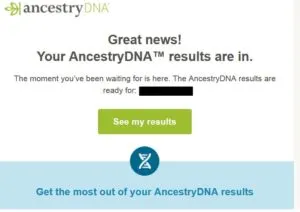
Let me just tell you that within five minutes of logging into the Ancestry DNA account associated with this test kit, I was able to determine that I was 100% correct in the test family tree that I had built!
Success! We had found out for sure - using DNA as the proof - who Bonnie's biological father was. It was Nicholas! Fantastic.
The first things that I noticed when I logged in were the shared ancestor hints:
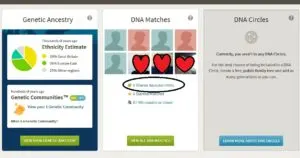
When I clicked through to see this shared hints, I saw that Bonnie had a first cousin DNA match that shared the exact set of grandparents that I had put in the family tree that I built for her. I also scrolled through some of the other DNA matches that were not from Jennie's side and saw lots of the same surnames from the tree.
The other neat thing that I noticed was the genetic community that Ancestry DNA placed my relative in (if you click on the genetic community link from the main screen, it will take you to another screen that tells you more details):
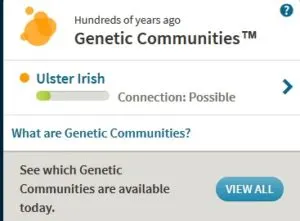
There is no Irish from Bonnie's mother's side of the family... so even if we had not found that close first cousin match who had matching grandparents, we still would have learned that all that we thought was true: Bonnie's dad was really Irish, just like the older family member remembered.
Did Bonnie find her father using DNA?
This story has the best possible ending. Bonnie immediately reached out to her first cousin match. The first cousin was so excited to hear from her because it turns out that everyone in the whole family had always known about her.
It is a close-knit family, and all of the aunts, uncles, and cousins always knew that Bonnie was out there somewhere, but they just didn't know how to go about looking for her.
Bonnie now gets to travel and meet her father's entire extended family. She has seen photographs of her father, her grandparents, great-grandparents, aunts, uncles, cousins, etc.
It's a sweet, sweet ending for a long life of looking for where she came from. I couldn't be happier for her!
* Names have been changed in this story to protect privacy
How do you know if you have a close family member on your DNA match list?
Check out this chart to see if you have any matches that fall into these categories:
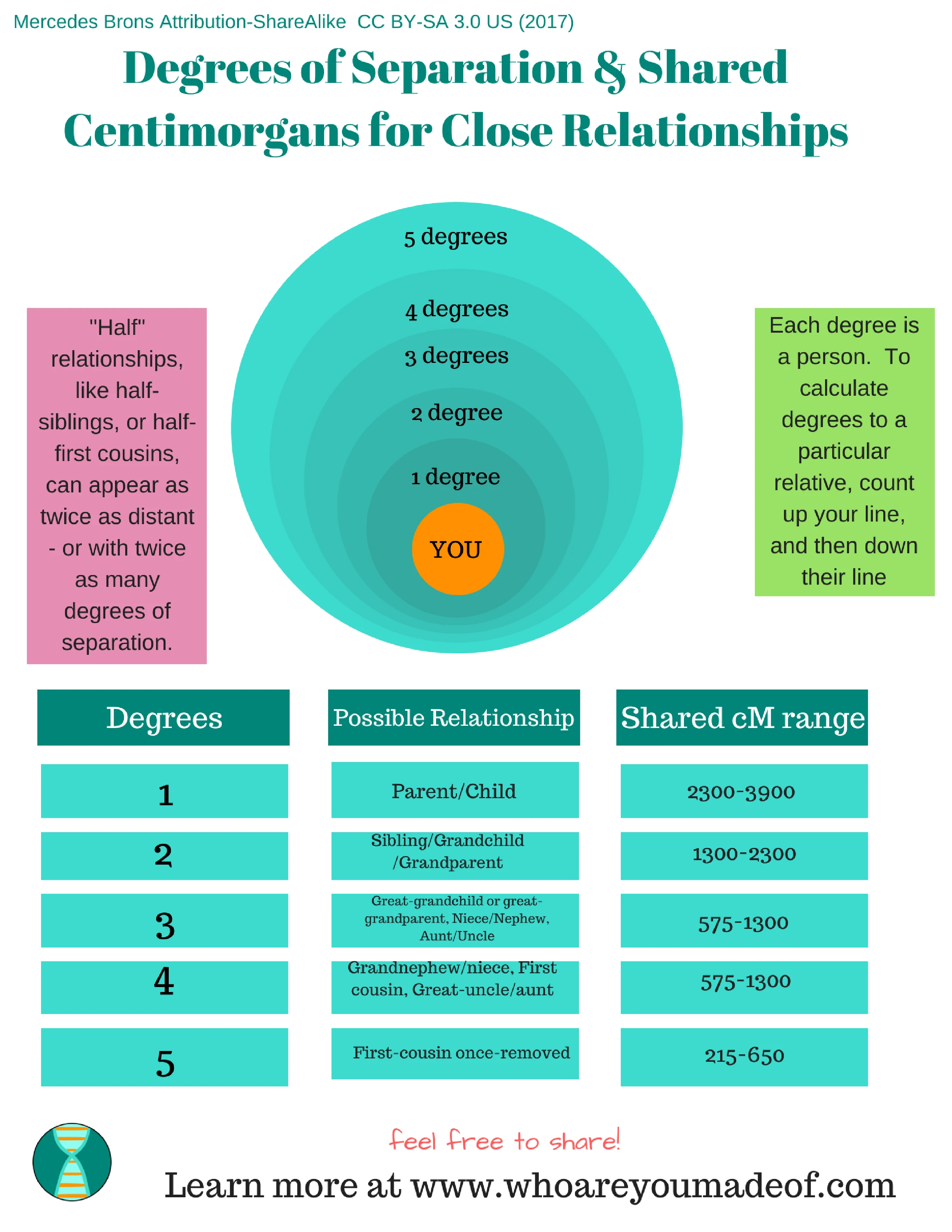
How can this story help you find your biological family using DNA?
I can't guarantee that your search will be as easy, or have such an amazing conclusion as Bonnie's, but doing a DNA test and learning how to understand your results will absolutely bring you much closer to knowing your truth.
If you already did your DNA test, you might be interested in my book (for DNA beginners) that helps you learn how to analyze DNA and get the most from your results.
If you have any questions, or if you are searching and would like me to take a look at your results, please e-mail me or post a message in the comments.
Thanks for stopping by!


Brenda Glidewell
Monday 11th of July 2022
Hi, I’ve found out that the person who was my bio dad isn’t but a family member close to my late mom, all the so called men are dead that could be the so called daddy. I found out that I have the HFE gene that both parents would have had in order for me to have it. My girl cousin and I look like sisters. I don’t know what kind of DNA test to get my answers from! Please help. Thanks Brenda
Jeannene Yanakieff
Sunday 6th of February 2022
On Ancestry, my Truelines says on my mother's side of family, my nephew is my half nephew and my deceased brother is my half brother. I do have half cousins on my mother's side. I have DNA matches on both sides, father and mother. I sent for my birth certificate and my father's name is on it. So is my brother my half brother and my nephew, my half nephew?
Sincerely, Jeannene
Gracie J
Tuesday 27th of July 2021
Hi Mercedes! Searching for my husband's bio father. I have found a common couple between his closest matches, who are 1/2 1st cousins to each other. The male match is closest match of 508 cM, 7% shared DNA, 1st - 2nd cousin and the 2nd match is a female 2nd - 3rd cousin, 5% shared and 320 cM. I have created trees for both sides of the common couple. I talked with the 2nd - 3rd cousin and she gave info that the other close match is her 1/2 1st cousin. I was able to do extensive research and build trees from there. I found the 1/2 1st cousins shared grandmother, who was married several times so different grandfathers. There are many matches from maternal side of his father but none from paternal side. I have communicated with a close family member of my husbands closest match, and because there are no other 'Knight's' (surname of closest match who is a male) he does not think my research is correct as to who I have determined to be a good candidate of the bio father in the 'Knight' family. He is going by matches on his wife's DNA (he manages her ancestry data of Knight family) saying he doesn't see my husband on her list or in uploaded DNA on other sites but see's her other family members that have tested. Am I on the wrong track? I thought finding a common couple would lead me to both sides of bio father. I have uploaded DNA to GEDmatch and did familyTreeDNA test, but receive no info on either of these sides. Only further generations back. Any help you can give would be greatly appreciated!! Thanks Mercedes! Gracie J
stephanie GM
Monday 26th of July 2021
I've been looking for my Grandfather, before there was even DNA ancestry. He died in France, ww2. My dad grew up in France, and his mother's side I have been able to research, but not his dad's. I haven't been able to find anything, even with the DNA. I really want to try and find him before my dad passes, to give him closure. My dad is now in fragile health, and only has a photo, not even a first name. Dad has spent his whole life wondering who is father was, the same as I have about my grandfather. I have done Ydna tests, ftdna, 23and me, gedmatch, myheritage, geneanet, and ancestry....and have found second to fourth cousins, but no one can help. Its very frustrating. Do you have any suggestions? Thank you
CChalette Lawrence
Saturday 19th of September 2020
I don't have any information except the month and year my son was conceived and the location of the fling which was a College. I remember what he looks like cause my son looks just like him. I dont remember his name or anything.
Donna Kennedy
Thursday 15th of October 2020
Was he enrolled at that college? Browse through their yearbooks for the possible years he might have been there.